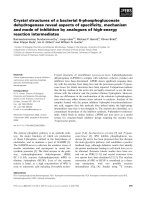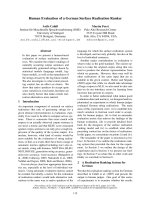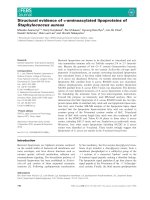Báo cáo khoa học: " Persistent occurrence of a single Streptococcus equi subsp. zooepidemicus clone in the pig and monkey population inIndonesia" ppsx
Bạn đang xem bản rút gọn của tài liệu. Xem và tải ngay bản đầy đủ của tài liệu tại đây (538.5 KB, 3 trang )
-2851$/ 2)
9H W H U L Q D U \
6FLHQFH
J. Vet. Sci.
(2004),
/
5
(3), 263–265
Persistent occurrence of a single
Streptococcus equi
subsp.
zooepidemicus
clone in the pig and monkey population in Indonesia
Siti Isrina Oktavia Salasia
1,4
, I Wayan Teguh Wibawan
2
, Fachriyan H. Pasaribu
2
, Amir Abdulmawjood
3
,
Christoph Lämmler
4,
*
1
Faculty of Veterinary Medicine, Gadjah Mada University, Sekip Unit II, Yogyakarta 55281, Indonesia
2
Faculty of Veterinary Medicine, Institut Pertanian Bogor, Jl. Taman Kencana no. 3, Bogor 16151, Indonesia
3
Institut für Tierärztliche Nahrungsmittelkunde, Justus-Liebig-Universität Gießen, Frankfurter Str. 92, D-35392 Gießen, Germany
4
Institut für Pharmakologie und Toxikologie, Justus-Liebig-Universität Gießen, Frankfurter Str. 107, D-35392 Gießen, Germany
In the present study 41 mucoid growing
Streptococcus
equi
subsp.
zooepidemicus
strains (37 strains isolated from
healthy two from diseased pigs, two strains isolated from
healthy monkeys) appeared to be phenotypically and
genotypically identical to mucoid growing
S. equi
subsp.
zooepidemicus
strains isolated from a previously described
outbreak among the pig and monkey population on the
island of Bali, Indonesia. These findings indicate that the
mucoid growing
S. equi
subsp.
zooepidemicus
clone was
still present in the pig and monkey population in
Indonesia.
Key words:
S. equi
subsp.
zooepidemicus
, pig, monkey, epi-
demiological relation
Streptococcus equi
subsp.
zooepidemicus
is well known
from infections of a wide variety of animals, including pigs,
sheep, cows, goats, foxes, birds, rabbits, guinea pigs, and
monkeys [11,15,16]. All these animals might be potential
reservoirs for infections of humans. Cases of human
infections with
S. equi
subsp.
zooepidemicus
have been
reported, and such infections are frequently associated with
the consumption of homemade cheese or unpasteurized
milk [3,4,6]. The isolation of
S. equi
subsp.
zooepidemicus
from humans has been described in cases of endocarditis
[13], pneumonia [14], meningitis [8,12], septic arthritis
[2,9], and cervical lymphadenitis [10]. At the beginning of
1994, a disease outbreak among pigs and monkeys was
reported on the island of Bali, Indonesia. The first cases
were reported among animals of a pig owner in a small
village on the island of Bali. In the following weeks and
months, the outbreak spread rapidly to the surrounding
districts in Bali, to other islands of Indonesia and into a
monkey population. The diseased animals showed clinical
symptoms such as painful swelling of the joint, respiratory
disturbances, and diarrhea. Most of the animals died within
a few days. The postmortem examination of the pigs and
monkeys revealed signs of polyarthritis, bronchopneumonia,
pleuritis, epicarditis, endocarditis, and meningitis [5]. The
bacteriological examination resulted in the isolation of
streptococci of Lancefield group C. The bacteria were
identified as
S. equi
subsp.
zooepidemicus
. A DNA
fingerprinting revealed identical profiles, indicating that a
single virulent clone was the causative agent of the various
pig and monkey infections on the island of Bali and the
other islands of Indonesia [15]. These findings raises the
question whether the bacterial clone discovered in 1994
remained to be present in the pig or monkey population. The
present study was designed to further characterize
S. equi
subsp.
zooepidemicus
isolated from healthy and diseased
pigs and monkeys on the islands of Bali and Java, Indonesia
between the years 1995 to 1998.
A total of 49
β
-hemolytic streptococci were investigated
in this study. Thirty nine streptococci were isolated from
tonsils of 39 healthy pigs in the slaughter house in Denpasar,
Bali, Indonesia, during a period of 4 years (1995, one strain;
1996, three strains; 1997, two strains; 1998, 33 strains), two
streptococci were isolated in 1997 from two diseased pigs in
Yogyakarta, Central Java, Indonesia, and two streptococci
were isolated from two clinically healthy monkeys from a
Bali monkey resort in 1995. The isolates were compared
with six
S. equi
subsp.
zooepidemicus
obtained from the
original outbreak in the year 1994.
The bacteria were cultivated on sheep blood agar plates
(Oxoid, Wesel, Germany) and in Todd-Hewitt broth (Gibco
Europe, Karlsruhe, Germany) and identified biochemically
according to Farrow and Collins [7] and Barnham and Cole
[2], serologically with autoclaved extracts of the bacteria
and group C specific antiserum in immunodiffusion
*Corresponding author
Phone: 0049641-38406; Fax: 0049641-38409
E-mail:
Short Communication
264 Siti Isrina Oktavia Salasia
et al.
reactions and with a commercial grouping kit (Slidex
Strepto-kit bioMerieux, Nürtingen, Germany). The growth
pattern of the bacteria in fluid media and the morphology of
the bacterial colonies in soft agar was evaluated as described
previously [17]. For analysis of restriction fragment length
polymorphisms of the 16S ribosomal RNA gene of the
cultures, the 16S rRNA gene was amplified by polymerase
chain reaction (PCR) with oligonucleotide primers (primer
1, 5
'
-GAG AGT TTG ATC CTG GCT CAG CA-3
'
, primer
2, 5
'
-CGG GTG TTA CAA ACT CTC GTG GT-3
'
) and
thermal cycler programs (Techne-Progene, Thermodux,
Wertheim, Germany) described previously [1]. The PCR
product was further investigated after restriction
endonuclease digestion with the restriction enzyme
Hinc
II
(Biolabs, Schwalbach, Germany) [1]. The preparation and
Sma
I digestion of the chromosomal DNA for
macrorestriction analysis of the isolates by pulsed-field gel
electrophoresis was performed as described by Soedarmanto
et al.
[15].
According to cultural, biochemical and serological
properties, all 43 isolates (41 from pigs, two from monkeys)
investigated in the present study and the six cultures of the
original outbreak were
β
-hemolytic, belonged to
Lancefield’s serological group C and could be identified as
Streptococcus equi
subsp.
zooepidemicus
. Upon cultivation
of the bacteria on blood agar, all 43 isolates and three strains
from the original outbreak grew in large mucoid colonies.
As already described [15] the remaining 3
S. equi
subsp.
zooepidemicus
strains obtained from the original outbreak
grew on solid media in small non mucoid colonies. All
group C streptococci that showed mucoid growth on solid
media grew with a uniform turbidity in liquid media and
exhibited a broad diffuse colony morphology in soft agar.
The remaining three
S. equi
subsp.
zooepidemicus
, obtained
from the original outbreak, showing non mucoid growth on
solid media, grew in liquid media as sediment with clear
supernatant, and with compact colonies in soft agar. The
growth properties of these three bacteria obtained from the
original outbreak had already been described [15].
According to studies of Abdulmawjood and Lämmler [1]
the V2 region of the 16S rRNA gene of
S. equi
subsp.
zooepidemicus
displayed intraspecific variations detectable
by endonuclease restriction of the 16S rRNA gene with the
restriction enzyme
Hinc
II. This allowed a molecular
identification and typing of isolates of this species. The size
of the amplified 16S rRNA gene product of all 43 strains of
the present investigation and the six control strains
investigated previously was approximately 1450 bp relative
to the DNA size marker. After digestion with
Hinc
II two
fragments with sizes of approximately 1250 bp and 200 bp
could be observed for all strains investigated indicating no
intraspecies variation in this gene segment (Fig. 1). To
further investigate the relation of the
S. equi
subsp.
zooepidemicus
strains the 43 isolates and the six previously
investigated strains were subjected to macrorestriction
analysis of their chromosomal DNA by pulsed-field gel
electrophoresis. The
Sma
I restriction pattern of all 43
S. equi
subsp.
zooepidemicus
, isolated from healthy and diseased
pigs and monkeys on the island of Bali and Java were
identical (Fig. 2) and corresponded to the PFGE pattern of
four of the six
S. equi
subsp.
zooepidemicus
obtained from
the original outbreak in 1994. As described previously [15]
two
S. equi
subsp.
zooepidemicus
, obtained from the
original outbreak, differed from the PFGE pattern of the
other 45
S. equi
subsp.
zooepidemicus
strains in two
fragments (not shown data).
According to their phenotypic and genotypic properties all
S. equi
subsp.
zooepidemicus
cultures isolated between 1995
and 1998 appeared to be identical to the original outbreak
strain from the year 1994. However, the 43 isolates of the
present study were obtained from healthy pigs and monkeys
from Bali, two isolates from Java from diseased pigs. These
F
ig. 1.
Typical fragments of the PCR amplified 16S rRNA ge
ne
o
f the
S. equi
subsp.
zooepidemicus
strains; line 1 before a
nd
l
ines 2-4 after digestion with the restriction enzyme
Hinc
II. M
=
a
100-bp ladder (Gibco BRL Life Technologies, Eggenstei
n,
G
ermany) served as size marker.
F
ig. 2.
PFGE analysis of chromosomal DNA of eight
S. eq
ui
s
ubsp.
zooepidemicus
strains after digestion with endonuclea
se
S
ma
I. M = lambda DNA (
Hind
III fragments 0.1-200 kb), a
nd
l
ambda DNA concatemeres (50-1000 kb) (both Sigma, Deisenhofe
n,
G
ermany).
Persistent occurrence of
Streptococcus equi
subsp.
zooepidemicus
in the pig and monkey in Indonesia 265
results indicated that the mucoid
S. equi
subsp.
zooepidemicus
clone isolated during the pig and monkey
disease in 1994 is, at least till the year 1998, still present in
the pig and monkey population on the various islands in
Indonesia. The isolation of the strains generally from
animals without signs of the previous diseases might be
caused by a specific immunity of the pig and monkey
population towards this bacterial strain. However, at present
nothing is known about the zoonotic potential of this mucoid
ß-hemolytic streptococcal clone, possibly distributed by
healthy pigs, for people who consume pork meat on the
island of Bali. The future investigation of specimen from
healthy and diseased humans, pigs and monkeys and also
from other animals might elucidate the possibly existing
epidemiological relation.
Acknowledgment
The support of Alexander von Humboldt Foundation,
Germany is gratefully acknowledged.
References
1. Abdulmawjood A, Lämmler C. Determination of
intraspecies variation of the V2 region of the 16S rRNA gene
of
Streptococcus equi
subsp.
zooepidemicus.
Res Vet Sci
2000, 68, 33-39.
2. Barnham M, Cole G. Characterization of
Streptococcus
zooepidemicus
(Lancefield group C) from human and
selected animal infections. Epidemiol Infect 1987, 98, 171-
182.
3. Barnham M, Thornton TJ, Lange K. Nephritis caused by
Streptococcus zooepidemicus
(Lancefield group C). Lancet,
1983, 321, 945-948.
4. Colman G, Efstratiou A. The investigation of outbreaks of
infection caused by human strains of Lancefield group C or
group G streptococci. In: Kimura Y, Kotami S, Shiokawa Y
(eds.). Recent Advances in Streptococci and Streptococcal
Disease. pp. 30-31, Reedbooks, Chertsey Surrey, 1985.
5. Dharma DMN. Wabah streptokokkosis pada babi dan kera
di Bali. Inlavet 1994, I(2), 1-2.
6. Duca E, Teodorovici G, Radu C, Vita A, Talasman-
Niculescu P, Bernescu E, Feldi C, Rosca V. A new
nephritogenic streptococcus. J Hyg 1969, 67, 681-698.
7. Farrow JAE, Collins MD. Taxonomic studies on
streptococci of serological group C, G and L and possibly
related taxa. System Appl Microbiol 1984, 5, 483-493.
8. Ghoneim AT Cooke AM. Serious infection caused by group
C streptococci. J Clin Pathol 1980, 33,188-190.
9. Gorman PW, Collins DN. Group C streptococcal arthritis: a
case report of equine transmission. Orthopaedics 1987, 10,
615-616.
10. Köhler W, Cedeberg A. Case report:
Streptococcus
zooepidemicus
(group C) as cause of human infection. Scand
J Infect Dis 1979, 8, 217-218.
11. Lämmler C, Hahn G. Streptokokken. In: Blobel H,
Schließer Th (eds.). Handbuch der bakteriellen Infektionen
bei Tieren. Band II/2. pp. 7-141, Gustav Fischer-Verlag, Jena,
1994.
12. Low DE, Young MR, Harding GKM. Group C
streptococcal meningitis in an adult: probable acquisition
from a horse. Arch Intern Med 1980, 140, 977-978.
13. Martinez-Luengas F, Inclan GM, Pastor A, Montejo M,
Barron J, Baroja A, Aguirre C. Endocarditis due to
Streptococcus zooepidemicus
. Can Med Assoc J 1982, 127,
13.
14. Rose HD, Allen JR, Witte G.
Streptococcus zooepidemicus
(group C) pneumonia in human. J Clin Microbiol 1980, 11,
76-78.
15. Soedarmanto I, Pasaribu FH, Wibawan IWT, Lämmler
C. Identification and molecular characterization of
serological group C streptococci isolated from diseased pigs
and monkeys in Indonesia. J Clin Microbiol 1996, 34, 2201-
2204.
16. Stableforth AW. Streptococcal disease. In: Stableforth AW,
Galloway IA (eds.). Infectious Disease of Animals. Disease
due to Bacteria. pp. 589-650, Academic Press, New York,
1959.
17. Wibawan IWT, Lämmler C. Properties of group B
streptococci with protein surface antigens X and R. J Clin
Microbiol 1990, 28, 2834-2836.






![Tài liệu Báo cáo khoa học: Specific targeting of a DNA-alkylating reagent to mitochondria Synthesis and characterization of [4-((11aS)-7-methoxy-1,2,3,11a-tetrahydro-5H-pyrrolo[2,1-c][1,4]benzodiazepin-5-on-8-oxy)butyl]-triphenylphosphonium iodide doc](https://media.store123doc.com/images/document/14/br/vp/medium_vpv1392870032.jpg)


